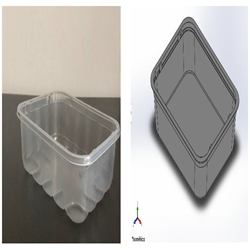Synthetic base fluids have been introduced to substitute non-environmentally friendly diesel at strict discharged regulation area, particularly in sensitive marine zone. Issues such as high viscosity and pour point, poor thermal and hydrolytic stabilities limit the manipulation of ester for various drilling fluid’s density and oil-water ratio (OWR) at high pressure-high temperature (HPHT) although it is superior in biodegradability, lubricity and zero aromatic content. In addition to that, nanomaterials have been proven in improving drilling fluid’s properties, especially in water based. Nevertheless, there is very limited knowledge of nanomaterial’s role in the improvement of ester-based drilling fluid (EBDF).
The main objectives of this work are to evaluate the performance of EBDF from 2-Ethylhexyl caprylate/caprate and to investigate the effects of carbon-based nanomaterials on EBDF for properties improvement. The ester was synthesized through a pulsed loop reactor and optimized by response surface methodology. The maximization of conversion (97.96%) and yield (89.43%) were achieved under optimum conditions of 78 °C of reaction temperature, 10 mbar of vacuum pressure, 20 minutes of reaction time and 155 rpm of oscillation speed. Important properties of 2-Ethylhexyl caprylate/caprate such as viscosity (3.26 cSt), density (862 kgm-3), pour point (-69 °C) and flash point (158 °C) have been analyzed according to ASTM standard and met drilling fluid’s base oil requirements.
Ester then has been formulated as drilling fluid at different OWR (70:30, 80:20, 85:15) and drilling fluid density (9.5 ppg, 12.5 ppg, 16.5 ppg) to suit with a wide range temperature (275 °F - 360 °F). The optimized formulation for condition of 70:30 OWR and 9.5 ppg (ester=180.30 lb/bbl; water=89.54 lb/bbl; calcium chloride=34.44 lb/bbl; primary emulsifier=8 lb/bbl; secondary emulsifier=6 lb/bbl; organophilic clay=3 lb/bbl; fluid loss control=8 lb/bbl; lime=2 lb/bbl and barite=67.89 lb/bbl) remained stable after 16 hours of hot rolling at 275 °F with satisfactory rheology (plastic viscosity = 22 cp and yield point =19 lb/100 ft2), electrical stability (601 V) and HPHT filtration properties (filtrate volume= 2.8 ml and cake thickness= 0.79 mm). The optimized formulation for HPHT conditions with 80:20 OWR and 12.5 ppg (ester= 177.16 - 182.72 lb/bbl; water= 51.32 - 52.93 lb/bbl; calcium chloride= 19.74 - 20.36 lb/bbl; primary emulsifier= 10 - 12 lb/bbl; secondary emulsifier= 2-6 lb/bbl, organophilic clay= 3 lb/bbl; fluid loss control=8 lb/bbl, lime 4=lb/bbl and barite=245.20 - 246.07 lb/bbl) remained stable after 16 hours of hot rolling at 300, 330 and 350 °F with satisfactory plastic viscosity (32-38 cp), yield point (17-20 lb/100 ft2), electrical stability (820-910 V) and HPHT filtration properties (filtrate volume= 2.8 - 3.8 ml and cake thickness= 0.79 - 1.59 mm). The ester also demonstrated the ability to tolerate high solid content with optimized formulation for 16.5 ppg (ester= 154.23 lb/bbl; water= 31.54 lb/bbl; calcium chloride= 12.13 lb/bbl; primary emulsifier= 12 lb/bbl; secondary emulsifier= 8 lb/bbl; organophilic clay= 3 lb/bbl; fluid loss control= 6 lb/bbl; lime= 2 lb/bbl and barite= 464.38 lb/bbl) which was also remained stable after 16 hours of hot rolling at 360 °F with satisfactory rheology (plastic viscosity= 69 cP and yield point= 36 lb/100 ft2), electrical stability (1416 V) and HPHT filtration properties (filtrate volume= 4.0 ml and cake thickness= 1.59 mm).
The 16.5 ppg of EBDFs demonstrated different properties in the presence of commercial graphene nanoplatelets (GNPs), in-house GNPs, graphene nanopowder, graphene oxide (GO) and carbon nanotube cotton (CNT cotton). Plastic viscosity increased to 10.14% (GO-EBDF), 4.35% (commercial GNPs-EBDF) and 2.90% (in-house GNPs-EBDF) while decreased to by 5.80% (graphene nano-powder) and 2.90% (CNT cotton) relative to Control. The GO augmented EBDF’s gel strengths by 27.27% (10 sec) and 12.5% (10 min) while the others gave a slight reduction of gel-strengths. The emulsion stability of EBDF improved with graphene nanopowder (1480 V) while decreased with other materials. HPHT filtration properties of EBDF was improved with graphene nanopowder (20% and 24.53% reduction of filtrates amount and cake thickness respectively). In addition to that, 0.007wt% is the optimum concentration of graphene nanopowder in 16.5 ppg EBDF. The improvement of properties of EBDF by graphene nanopowder may due to the action of graphene nanopowder as an inhibitor for micelle formation, a co-secondary emulsifier, a bridging agent and increases oil-wettability of filter cake.
As a conclusion, 2-EH caprylate/caprate has been successfully synthesized and optimized via a vacuum assisted-pulsed loop reactor. The performances of ester as green drilling fluid at HPHT conditions also has been demonstrated according to API 13B-2 standards. Graphene nanopowder enhanced the EBDF’s performance, particularly in the filtration properties. Finally, knowledge beyond the enhancement of EBDF through the addition of graphene nanopowder has been elucidated.
*Abstract of the thesis (PhD) by Siti Zulaika Razali.
For further information please contact:
Robiah Yunus, PhD
robiah@upm.edu.my
Date of Input: 31/07/2023 | Updated: 31/07/2023 | roslina_ar
MEDIA SHARING























